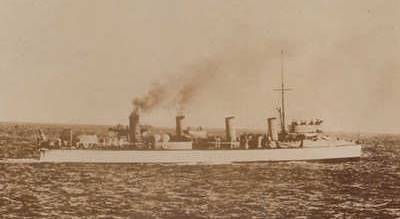Cecil William Francis was born 30 June 1898 to Henry William Francis, a carpenter who had married Lucy Evelyn Hugo from Cornwall. Lucy had come to work in Devon and in 1891 was working as a housemaid in Ilfracombe. With the expansion of the railways, Ilfracombe was being developed as a holiday destination and would have been a good place to visit from Winkleigh. Cecil was the second of three children, but as often happened his mother probably died as the result of having the third child Edward in 1900. Lucy’s sister Millice Alberta came to live with Henry and his three boys as a stand-in mother. Cecil eventually became a postman and joined the Navy on 19th October 1915, after he had been at a Navy training establishment. Consequently, he was immediately taken on as an Ordinary Seaman to complete his training for service which was completed on 15 December. It appears that he had lied about his age when joining the Navy as his service record has his birth date as 1897. He is also recorded as being 5ft 4in tall with a fresh complexion, blue eyes and brown hair. After a spell of leave over Christmas and New Year, Cecil joined HMS St Vincent on 16th January 1916 for six months experience afloat.
The St Vincent was a dreadnought battleship commissioned in 1910 and was 526 feet long with a compliment of 756 sailors. Her main armament were ten 12 inch guns, twenty four other guns and two torpedo tubes and she had a maximum speed of 21 knots. Cecil’s time aboard the St Vincent proved to be some experience as the St Vincent as she was part of the Home Fleet and was soon on her way to the Battle of Jutland. German shipping had been blockaded since early in the war and the German objective was to lure the Home Fleet to Germany so to could be destroyed. When the German Navy started to leave port at the end of May, the Home Fleet set out to stop them. There followed the biggest sea battle that has ever been fought, and the St Vincent was 20th in line of the attack. HMS St Vincent began her engagement of the German battleships around 18.40 and fired occasional salvos but visibility was poor due to smoke and no hits were observed. Then she fired on the disabled German light cruiser Wiesbaden, followed by altering course to evade the German torpedo attacks by two destroyer flotillas. At 19.15 the St Vincent sighted ships of the German 1st Scouting group and she opened fire on the Seydlitz followed by the Moltke. She hit the Seydlitz twice with the 12 inch guns at a range of 9,500 to 10,000 yards. At about 20.00, St Vincent reported another near miss from a torpedo with it passing between her and the Neptune. Because the German fleet executed a turn 180 degrees away, the St Vincent made no further contact after firing 98 shells. The German ships returned to port during the night and the Home Fleet withdrew from the area. The St Vincent was not hit or damaged during the battle. The outcome of the battle was indecisive and is still discussed today. The German Navy did not succeed in destroying the Home Fleet, but the British lost more ships and men than the Germans. The positive result for the British was that the Kaiser decreed that the German Navy should not put to sea unless success was assured. Submarines continued to be a constant threat and sunk two more ships of the Home Fleet a few weeks later. Thereafter, the St Vincent spent her time on routine patrols and Cecil returned to the shore establishment Vivid 1 at Devonport on 15th July for further training.
After four months training Cecil was posted to HMS Leander. The Leander was an obsolete cruiser that had been converted the depot ship for torpedo boat destroyers and was now at Scapa Flow. From Leander, Cecil was assigned to HMS Griffon, one of these destroyers. The Griffon was 210 feet long with a complement of 63 sailors. She had coal fired steam engines giving a top speed of 30 knots. The armament included one 12 pounder gun and two torpedo tubes. The destroyers were always busy, even just after the Battle of Jutland, because the threat of submarine attack was always present. After the loss of two ships soon after the Battle of Jutland, the Home Fleet based at Scapa Flow never went without destroyer escort.

HMS GRIFFON
At the end of January 1918, Cecil was promoted to Able Seaman and was transferred to HMS Victorious, an obsolete pre-dreadnought battleship that had been converted to a repair ship now for the Grand Fleet at Scapa Flow. This was presumably for training because Cecil was back on the Griffon after just seven weeks. However, his time aboard HMS Griffon was coming to an end, because he returned to Dartmouth on 22 July 1918. On 4 March 1919 Cecil returned to sea to complete his contract returning to Dartmouth Training Establishment on 19 June 1920 to be demobbed on 13 November 1920. However, it seems that civilian life did not suit him because he re-entered the Navy on 25th January 1921 as an Able Seaman under the Continued Service regulations with the new service number J100699. Nevertheless, it appears that he did not leave Winkleigh as he married a Winkleigh girl Ethel Joanna Mitchell in 1824.
19 October 2012


